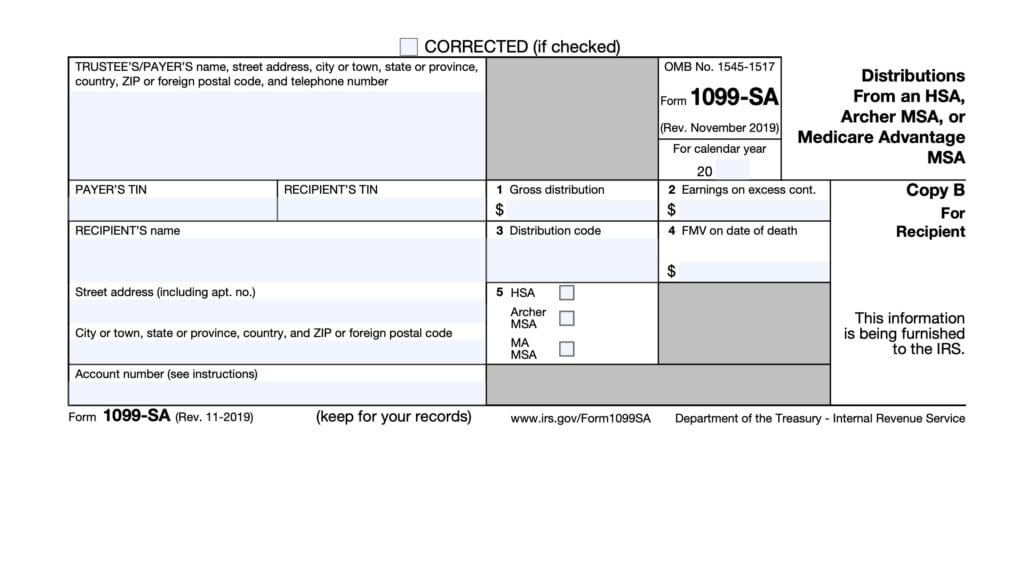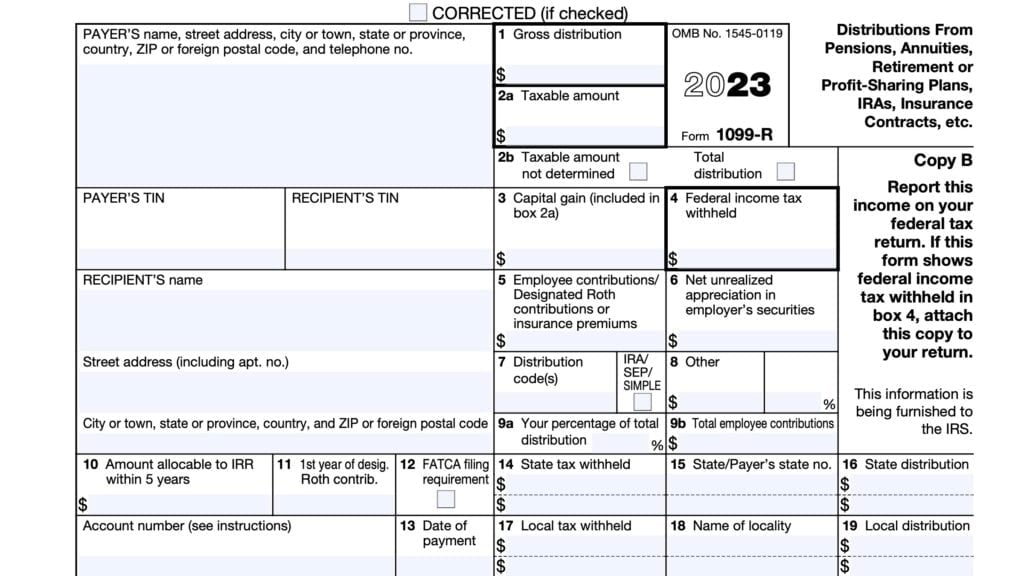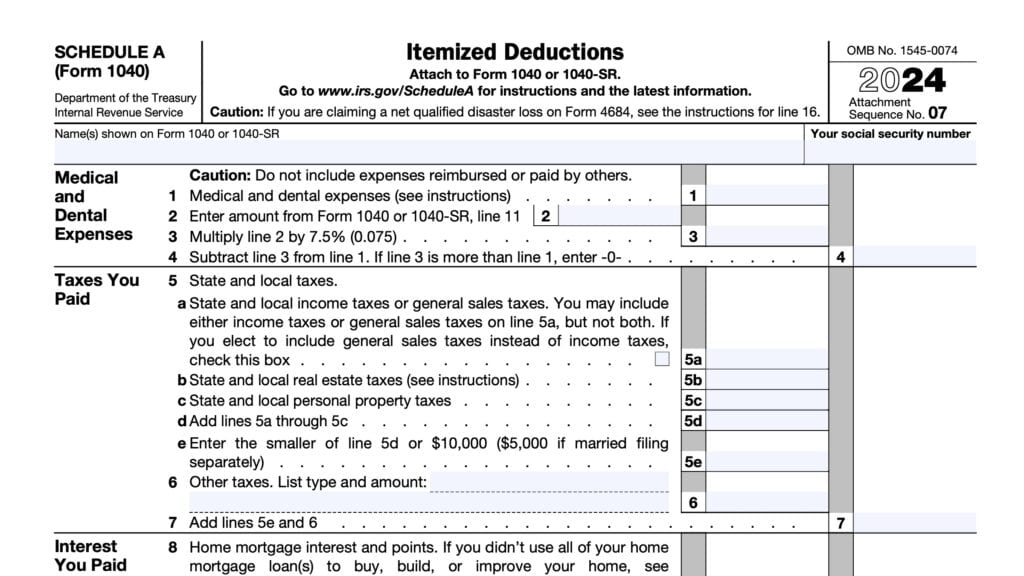IRS Form 5498-SA Instructions
If you participate in a health savings account (HSA) or Archer medical savings account (Archer MSA), you may receive IRS Form 5498-SA each year. Although this tax form is not required for you to file your income tax return, there is some useful information that may help you better understand your tax situation.
In this article, we’ll help you better understand this IRS tax form, including:
- How to read and understand IRS Form 5498-SA
- Annual contribution limits
- Frequently asked questions
Let’s begin with a top-down overview of IRS Form 5498-SA.
Table of contents
IRS Form 5498-SA Instructions
In most of our articles, we walk you through how to complete the tax form. However, many readers will probably want to understand the information reported on their IRS Form 5498-SA, instead of how to complete it.
There are generally 3 copies of this form that financial institutions must file. Copy A goes to the Internal Revenue Service, while Copy B goes to the account holder. The financial institution usually will retain Copy C for their records.
Let’s get into the form itself, starting with the payer and recipient information fields on the left side of the form.
Taxpayer information
In the boxes on the left side of the form, you should see your personal information, as well as the information for the financial institution.
Review these for accuracy, to make sure that the reported information is correct.
Trustee’s Or Issuer’s Information
This field should contain the following information with regards to the reporting institution:
- Trustee’s name or Issuer’s name
- Street address
- City, state, ZIP code
If you have any questions about any of the transactions reported on this form, you should have enough contact information to reach out to the financial institution for resolution.
Trustee’s TIN
Most likely, this will be an employer identification number, or EIN.
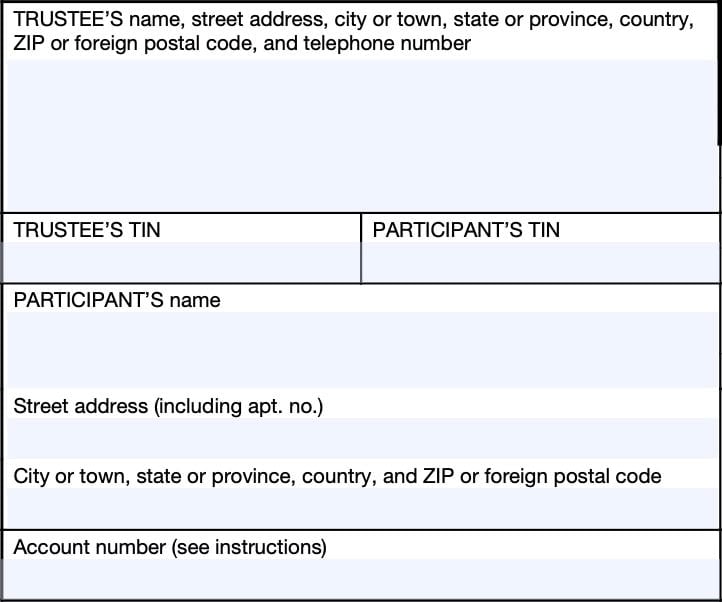
Participant’s TIN
This field should contain your Social Security number, or SSN. Quickly review this field for accuracy.
Your form may contain a truncated version of your SSN, for identity theft protection. However, Copy A, filed with the IRS, will contain your complete taxpayer information.
Participant’s Information
This field should contain your name and complete mailing address. Review this for incorrect information.
If you have recently moved and your new address does not appear on this form, then you should update your profile. Also, you should notify the Internal Revenue Service (if you have not already done so) by filing IRS Form 8822, Change of Address.
Account Number
If applicable, your account custodian may enter an account number in this field. If you have more than one IRA with the same custodian and the custodian sends you Form 5498-SA for each account, the custodian must enter account number information in this field.
Right side of Form 5498-SA
On the right side of the 5498-SA form, there are six fields, which may provide useful information. We’ll take a look at each one, starting with Box 1.
Box 1: Archer MSA Contributions made for the tax year
Box 1 contains the total amount of Archer medical savings account (Archer MSA) contributions made for the tax year.
For tax year 2023. this includes any Archer MSA contributions that were made during 2023 or in 2024 prior to the income tax return filing deadline.
Archer MSA contribution limits
Annual contribution limits for an Archer MSA depend on two factors:
- Whether your high deductible health plan (HDHP) is for self-only coverage or for family coverage
- The amount of your deductible on your health plan
For a self-only HDHP, an individual may contribute up to 65% of their annual deductible towards an Archer MSA. For taxpayers with family coverage, that annual limit is 75% of the deductible.
2023 Archer MSA contribution limits
For the 2023 tax year, here are the minimum and maximum deductibles, as well as the annual contribution limit, for an Archer MSA:
| Self-only coverage | Maximum contribution (65% deductible) | Family coverage | Maximum contribution (75% deductible) | |
| Minimum annual deductible | $2,650 | $1,722.50 | $5,300 | $3,975 |
| Maximum annual deductible | $3,950 | $2,567.50 | $7,900 | $5,925 |
Taxpayers report Archer MSA contributions on IRS Form 8853, Archer MSAs and Long-Term Care Insurance Contracts.
Box 1 will report gross contributions, including any excess contributions, even if the excess contributions were withdrawn. However, Box 1 should not contain any HSA information.
Box 2: Total contributions made in 2023
Box 2 contains the total amount made to either a health savings account (HSA) or Archer MSA in the current calendar year.
This includes any rollover contributions from an IRA or Roth IRA, also known as a qualified HSA funding distribution.
Qualified HSA funding distributions
A qualified HSA funding distribution allows a taxpayer to make a one-time trustee to trustee transfer from an IRA account into their HSA. The maximum qualified HSA funding distribution depends on the taxpayer’s age and type of plan coverage (self-only or family coverage) the taxpayer currently has.
The qualified HSA funding distribution:
- Is not included in gross income
- Is not tax deductible
- Reduces the total amount of HSA contributions a taxpayer can make in the calendar year
Reportable contributions to a health savings account, as well as HSA distributions, are reported on IRS Form 8889, Health Savings Accounts. Distributions from an HSA account, are reported on IRS Form 1099-SA, Distributions From an HSA, Archer MSA, or Medicare Advantage MSA.
Medicare Advantage MSA information
For Medicare Advantage MSA account holders, the trustee of your MA MSA may show contributions to your MSA. However, they are not required to do so.
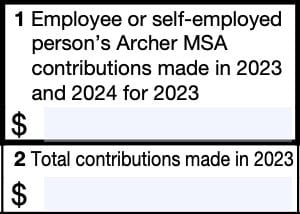
Box 3: Total HSA or Archer MSA contributions made in 2024 for 2023
Box 3 contains total contributions to either a health savings account or an Archer MSA made in a later tax year for the prior year. For example, Box 3 of the 2023 copy of Form 5498-SA would contain total contributions made in 2024 for 2023, the previous tax year.
Box 4: Rollover contributions
This box shows rollover contributions into this account.
If the account is an Archer MSA, Box 4 will indicate a rollover from another Archer MSA to this Archer MSA in 2023. For HSAs, this can include any rollover contribution from either an HSA or an Archer MSA to this HSA in the current year.
The Box 4 amount does not include any amounts reported in Boxes 1-3, nor are those amounts reflected in Box 4. Rollover contributions do not reduce the contribution limit for the tax year.

Box 5: Fair market value
Box 5 shows the fair market value of your HSA, Archer MSA, or MA MSA at the end of the tax year.
Box 6: Type of savings account
Box 6 indicates the type of savings account that is being reported. The trustee can select from:
- HSA (Health savings account)
- Archer MSA
- MA MSA (Medicare Advantage Medical Savings Accounts)
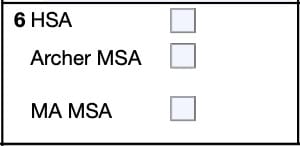
IRS Form 5498-SA considerations
IRS Form 5498-SA is an informational return, and most taxpayers do not need this tax form for tax reporting purposes. However, below is some useful and relevant information that may help for recordkeeping.
Archer MSAs
Generally, contributions you make to your Archer MSA are deductible.
Employer contributions are excluded from your income and are not tax-deductible. If your employer makes a contribution to one of your Archer MSAs, you can’t contribute to any Archer MSA for that year.
If you made a contribution to your Archer MSA when your employer has contributed, you can’t deduct your contribution, and you will have an excess contribution.
When your spouse’s employer makes a contribution to your spouse’s Archer MSA, you can’t make a contribution to your Archer MSA if your spouse is covered under a high deductible health plan that also covers you.
Any employer contributions made to an Archer MSA are shown on your Form W-2 in Box 12, marked with code R.
Medicare Advantage MSAs
Contributions that the Social Security Administration makes to your MA MSA aren’t includible in your gross income nor are they deductible. Neither you nor your employer can make contributions to your MA MSA.
Health savings accounts
Generally, contributions you or someone other than your employer makes to your HSA are deductible on your tax return. Employer contributions to your HSA may be excluded from your income and aren’t deductible by you.
Any employer contributions made to an HSA on your behalf are shown on your Form W-2 in Box 12, marked with code W.
Filing IRS Form 5498-SA
For tax entities who must file this tax form with the Internal Revenue Service, IRS regulations require certain tax documents, such as paper versions of information returns, to be accompanied by IRS Form 1096, Annual Summary and Transmittal of U.S. Information Returns.
Check out our step-by step instructional guide for more information on how to submit your information return with IRS Form 1096.
Variations Of Form 5498
IRS Form 5498-SA is used to report contributions to an HSA or MSA. However, other versions of this tax form are used to report similar transactions in other tax-advantaged accounts.
These include:
- Form 5498: IRS Form 5498 provides IRA contribution information to respective account holders. Includes catchup-contributions for taxpayers age 50 and older.
- Form 5498-QA: IRS Form 5498-QA is used to report contributions to a qualified ABLE (Achieving a Better Life Experience) account. ABLE accounts are tax-advantaged savings programs for qualified people with disabilities.
- Form 5498-ESA: IRS Form 5498-ESA is used to report contributions to a Coverdell Education Savings Account (ESA)
Video walkthrough
Check out this instructional YouTube video to learn more about IRS Form 5498-SA.
Frequently asked questions
The custodian of a health savings account or medical savings account must mail a copy of Form 5498-SA to MSA or HSA account holders no later than May 31 for contributions made during the previous year. For 2023 contributions, the due date is May 31, 2024.
Yes. HSA contribution limits are based upon the deductible for the respective high deductible health plan that the taxpayer participates in. However, according to IRS Publication 969, taxpayers age 55 and older may contribute an additional $1,000 each tax year.
The IRS does not require taxpayers to retain Form 5498-SA for tax purposes. However, in case of an audit, Form 5498-SA may help provide additional information. Taxpayers should always consult their tax professional to determine which tax documents to keep, and which ones they can safely destroy.
Where can I find IRS Form 5498-SA?
As with most tax forms, you may find IRS Form 5498-SA on the IRS website. For your convenience, we’ve attached the latest version of IRS Form 5498-SA to this article.

